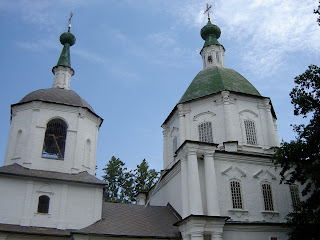Last Wednesday, we were treated to a tour of central Moscow by Milla. Milla is an English-speaking, German woman who was married to a Russian. Got all that? The sites toured included The Kremlin, Red Square, The Cathedral of Christ the Saviour and the Novodevichy Convent and Cemetery. First, it will be helpful to define some terms:
Moscow - Russian for "dark water." The soil around Moscow contains clay which darkens the appearance of the Moscow River.
Kremlin - Russian for "fortress."
Red - Old Russian for "beautiful." Hence, Red Square, as commonly thought, is NOT named to honor Russian Communism. It's only an unfortunate coincidence.
The Kremlin - a three-sided fortress along the Moscow River. There are 20 towers incorporated into the fortress wall. Within The Kremlin are government buildings, royal palaces, museums, residences and cathedrals.





St. Basil's Cathedral - Commissioned by Ivan the Terrible to commemorate his victory over the ruling Turks. It is famous for it's colorful onion domes and is positioned on the southeast corner of Red Square. The cathedral was designed by two Italian architects, a fusion of European and Asian design. The story goes that Ivan was taken with the beauty of the church and, so that another like it could not be built, had the eyes of the two Italians gouged out.


Red Square - flanks the east side of The Kremlin and was originally named Market Square. The name change was believed to have taken place in the 17th century. The square seperated The Kremlin from a merchant district. Most of us recognize Red Square from seeing footage of Soviet military parades. To accomodate the tanks, weaponry and troops for the parades, a double arch at the north end of the square, which was the original gateway to the city, was removed. Since the dissolution of the Soviet Union, the double archway has been rebuilt. Also, Lenin's Tomb is located in Red Square.



The Cathedral of Christ the Saviour - Tallest Eastern Orthodox cathedral in the world. Built to commemorate the defeat of Napoleon's army in 1812. Sorry, cameras weren't allowed inside.

Novodevichy Convent - Translates to New Maidens' Monastery. Originally built as a fortress to defend the southern part of the city. Flanking the Convent wall is Swan Lake, which inspired the ballet of the same name by Tchaikovsky. Home of the the Novodevichy Cemetery mentioned in posts below.















































